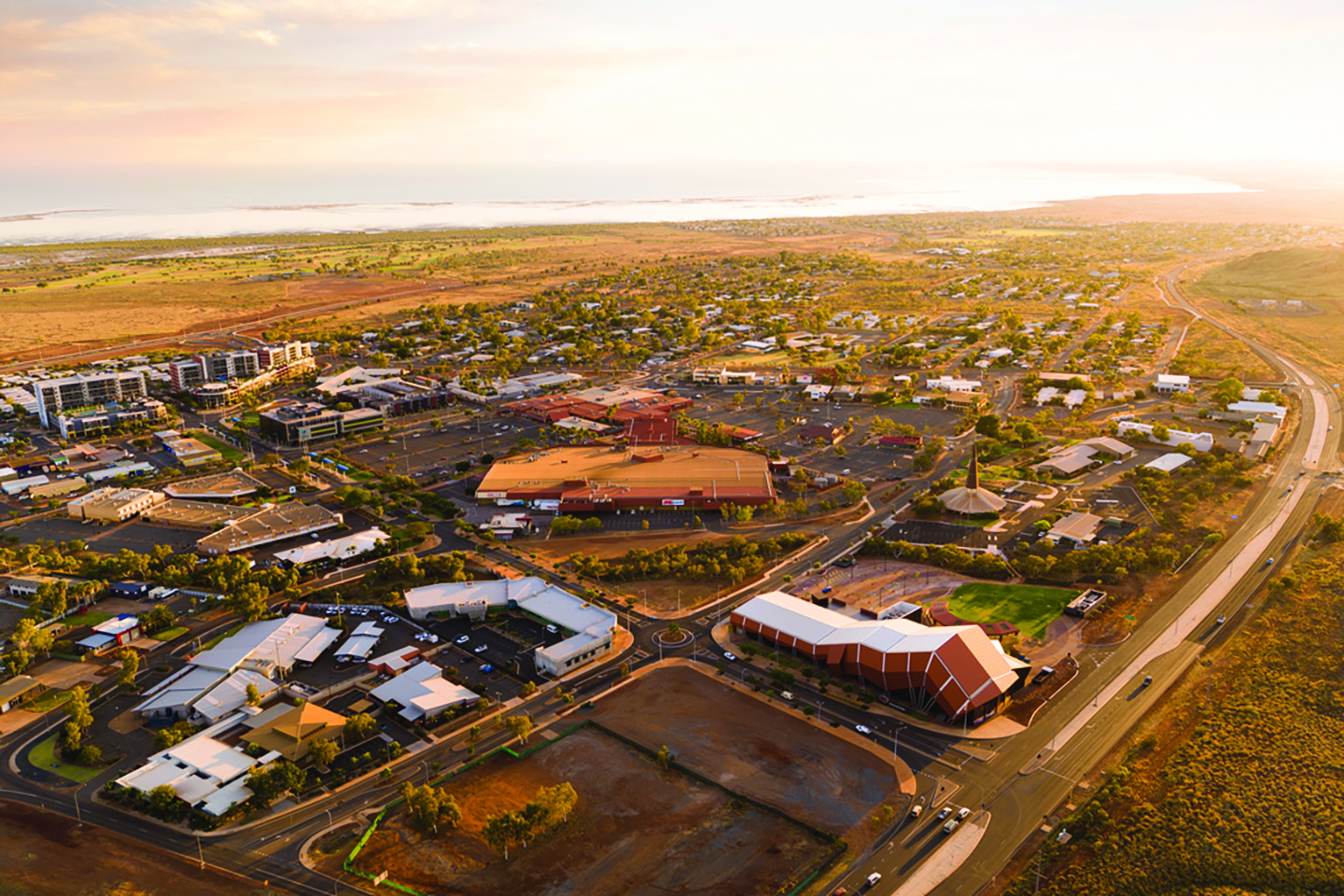Visionary infrastructure projects can drive huge advancement in regional communities, but the challenge is investing money wisely.


A multi-billion dollar gas pipeline linking the Pilbara to eastern Australia is on the list of potential infrastructure investments to ignite the economy following the COVID-19 pandemic.
Its investigation by the COVID-19 Recovery Commission is one of many big ideas for regional infrastructure that have been debated in Western Australia over the years.
Some have proceeded, and brought with them a lift in development, such as the Dampier to Bunbury Natural Gas Pipeline.
Others have fallen by the wayside, like the water canal, proposed in the 2005 state election.
(click here to view a PDF version of the full 12-page liftout)
Assessing the merits of mega-projects is a complicated challenge.
Karratha is an example of a city that benefited from bold economic development policy.
It was established in 1968 to service the iron ore industry.

An aerial view of Bulgarra, the first suburb in Karratha in 1970. Photo: City of Karratha Local History Collection, reproduced with the permission of the City of Karratha.
In the 1980s, however, the North West Shelf Venture gas project provided a major boost to the town.
The development of that gas resource was supported by a contract between the government’s State Electricity Commission of Western Australia and the project’s proponents, with a major pipeline connecting the plant and Perth in 1984.
It was later extended to Bunbury, and runs more than 1,500 kilometres.
Karratha now has a median household income of $2,643 per week, 66 per cent more than the WA average, according to the Australian Bureau of Statistics.
But there is major debate as to whether an interstate pipeline will be a winner for Western Australia.
Construction of the pipeline would mean WA gas being sent interstate, potentially benefiting east coast industry at the expense of WA.
Conversely, it could unlock previously uneconomic gas fields and create jobs.

Andrew Pickford is researching a PhD about the history and development of the energy industry in WA, and is executive director of Mannkal Economic Education Foundation.
Mr Pickford told Business News a transcontinental pipeline could be of benefit to WA, depending on circumstances.
“It’s not going to be cheap gas … and the other concern is it has the risk of being a wealth transfer,” he said.
If the pipeline was intended to drive increased gas use on the east coast, it might have merit.
“If that’s the proposal, it (could) stack up,” Mr Pickford said.
However, using the pipeline as a short-term response to high prices on the east coast, where gas fields are locked up, would not be worthwhile.
In that situation, one of managed decline, a regasification terminal to send WA LNG across the country might be a better option.
The caveats for a pipeline would be that it would need to be a quick build, with little red tape, and done on commercial terms.
“WA shifted to natural gas (from town gas) in the late 70s and early 80s,” Mr Pickford said.
“That radically shifted the whole WA grid and outlook.
“If we built a transcontinental pipeline it could spur on growth.
“The way it (will) get used in decades is different from how it was initially envisaged.”
While WA’s gas exporters may prefer to continue to focus on overseas markets, a transcontinental pipeline would not necessarily be a threat to WA, as long as the state was involved in decisions rather than having them imposed from Canberra.
“If you build capacity options it gives producers further (opportunities),” Mr Pickford said.
“It changes the economics of fields that may not otherwise be exploited.
“It gives a larger choice of options for producers … (pipeline connections are) one reason why the shale revolution is happening in the United States.
“It could spur on unforeseen investment opportunities.
“A national pipeline doesn’t necessarily need to subtract from a prosperous state.”
ACIL Allen undertook pre-feasibility work on a transcontinental pipeline, which was published in 2018, and warned it would be a long-term solution to what may be a transient problem.
But the consultancy said the option should be kept open.
“The West–East pipeline faces some major challenges that will be difficult to overcome, particularly while other, lower cost and more flexible options remain in prospect,” the report said.
“However, if these alternatives do not emerge in time to address the issue of securing long-term gas supply for the eastern States, the West-East pipeline could emerge as the best available option.”
The report said producers believed multiple new supply sources would need to be developed to feed a new pipeline.
“(Some) prospective fields were ‘medium’ scale which meant they were too big for the domestic market in Western Australia but not large enough to justify a new LNG train or to backfill an existing LNG train,” the report said.
“It was considered fields like this would be the ideal size to support a West-East gas pipeline.
“Stakeholders pointed to the fact that there was a lot of stranded gas in the north-west.
“However, development of fields in the Browse Basin was seen to be very challenging.
“One gas buyer referred to it as a ‘white space development’ with no infrastructure or amenity in place to underpin any offshore supply point, meaning that exploitation of these reserves would require the simultaneous development of a pipeline and a major offshore development.”
The report also found economic output would rise in WA across the two decades after construction, but that may not flow through to residents.
“This is because although the gas production is happening in Western Australia, the taxes and profits are distributed elsewhere – notably to eastern Australian residents (on the basis of relative population size) and to foreign equity owners,” the report said.
“On a per capita basis, the growth in real incomes of Western Australians is comparable with the growth in eastern Australia.”
Documents recently leaked in other media outlets show the COVID-19 Recovery Commission’s manufacturing taskforce favoured using government balance sheets to underwrite new supply.
That would encourage upstream investment, the taskforce said.
The documents offered hopes to reduce gas supply costs to $4 per gigajoule, although it was not clear exactly how the figure would be achieved.
There’s also work under way by the WA state government to investigate potential industrial developments using gas.
That would mean encouraging value adding industries, which use gas as a feedstock.
Examples of potential developments are in methanol, hydrogen, urea and lithium hydroxide.
Mr Pickford said clearing out bureaucracy and reducing investment uncertainty were as important as having a supply of gas itself.
“(Gas) costs to produce, and there’s an opportunity cost of not putting it on a boat and sending it to Japan or China,” he said.
“Any time a government tries to get too active in backing a new source or process … it gets problematic.
“It’s better for the government not to be deciding x is the outcome (but) focusing on attractiveness for investment and special economic zones, more open and aggressive ways of courting foreign capital.”
ACIL Allen executive director of WA and NT John Nicolaou said the government was motivated by encouraging economic diversification.
“We’re the largest exporter of natural gas in the world,” Mr Nicolaou said.
“We have vast reserves, economic and stranded.”
One topic for consideration is businesses using gas as feedstock on the Burrup Peninsula, near the existing Karratha Gas Plant.
Projects could be supported by potential investments by the government, including port facilities, roads and power generation, Mr Nicolaou said.
But the economics needed to stack up, he said.
“If the state is proactive in supporting development by providing answers to essential questions … it makes it easier for investments to move forward,” Mr Nicolaou said.
Water
In a state as dry as WA, water infrastructure has long been a big topic of debate.
While the Goldfields Water Supply Scheme, completed in 1903, generated much controversy at the time, there have been debates over more recent initiatives.
A particularly famous example was Colin Barnett’s proposal in 2005 to build a canal carrying water from the Kimberley to Perth.
The idea had also reportedly been touted by former Labor politician Ernie Bridge in the 1980s.
As an alternative, the Gallop Labor government opted to build a desalination plant in Kwinana, and a second such facility followed in Binningup, further south.
Ken Perry, who was formerly chief executive of drilling business Brandrill, thinks improved water supply would have a big impact in the Pilbara.
Mr Perry said a canal should be built from the Kimberley through to Port Hedland and Karratha to irrigate pastoral land.
An alternative would be desalination, he said.
“Water is key,” Mr Perry said.
“All you need to make Port Hedland and Karratha nicer places is water.”
He said it would spark productive potential, and cited the Carnarvon market gardens as an example.
Mr Perry, who had previously been a key proponent of the Pilbara Cities policy of investing into the north, said development would require vision.
There are existing examples of irrigation of land in the Pilbara.
Possibly the best known is Pardoo Beef Corporation, which accesses an underground water supply to grow feed for cattle.
“(Pardoo) achieved an agreement with the government in 2015 to access the freehold option and has followed a long process with many government departments, which has now substantially progressed along the agreed pathway,” a spokesperson for Pardoo said.
“As the first proponent for this initiative, there have been learnings along the way for both Pardoo Beef Corporation and (the) government.
“During this time, the operation has invested in 20 (irrigation) pivots, and grown from 3,500 mixed-breed animals to a large Wagyu herd.
“Pardoo’s experience is that it is a very lengthy, complex, and costly process to gain approvals and pioneer a new industry at the same time.”
But the company said it was working well with regulators, and was engaging with Meat & Livestock Australia on researching a number of areas, including irrigation.
Pardoo sells beef into China, Hong Kong, Thailand, Singapore and Middle Eastern markets.
Other agribusinesses may follow that path of using aquifer water, if regulations do not impede it.
Power
In the electricity sector, there’s a decided move away from big projects.
That has been boosted by rapid technological change, as distributed generation supported by storage systems becomes much more economical.
Microgrids and standalone power systems have been rolled out in parts of the state to replace centrally connected networks.
Standalone systems usually involve solar power, batteries and back-up diesel for one customer, while microgrids are miniature networks that power towns or mines.
Western Power installed six standalone power systems as part of a trial in 2016, and found they improved reliability.
“(P)ilot customers experienced a significant reliability improvement with an average outage duration of 4.66 hours for this period versus 69.59 hours had the same customers been network connected,” a report by the company said.
More than 3,000 of the units could be installed across the southern parts of WA to avoid hundreds of millions of dollars of capital expenditure costs in the next 50 years replacing poles and wires in the existing grid.
A further 60 units were announced as part of a roll out last year.
Renewable-powered microgrids have been built in towns like Onslow, by Horizon Power, and Kalbarri, by Western Power.
Magellan Power has been a supplier on many of these projects, and founder Masoud Abshar said the new technology had a big impact on reliability.
“There are lots of towns in WA being fed by an overstretched grid, they get very unreliable power,” Mr Abshar said.
“(Microgrids and standalone systems) put all the problems of the overstretched grid right.
“The idea is to design a system, so the diesel generator doesn’t have to come on … only when very necessary.
“The more remote it gets the costlier (diesel generation) gets.”
Mr Abshar is a big proponent of contracting locally for the systems, and said Australia had an opportunity to become a world leader in supplying the technology.
While Western Power focuses on the region in the state’s south, there has also been discussion about using the systems to help pump water to irrigate pastoral land more cheaply in the Kimberley.
This would replace diesel generators.
Mannkal’s Mr Pickford said microgrids and standalone systems were good options in some circumstances.
“They’re a fantastic option where the cost of transporting fuel or (of) legacy infrastructure is too much,” he said.
“If you were doing it with a clean sheet, the South West Interconnected System would be a lot smaller.”
But it was important decisions were based on economics and not politics, Mr Pickford said.

















